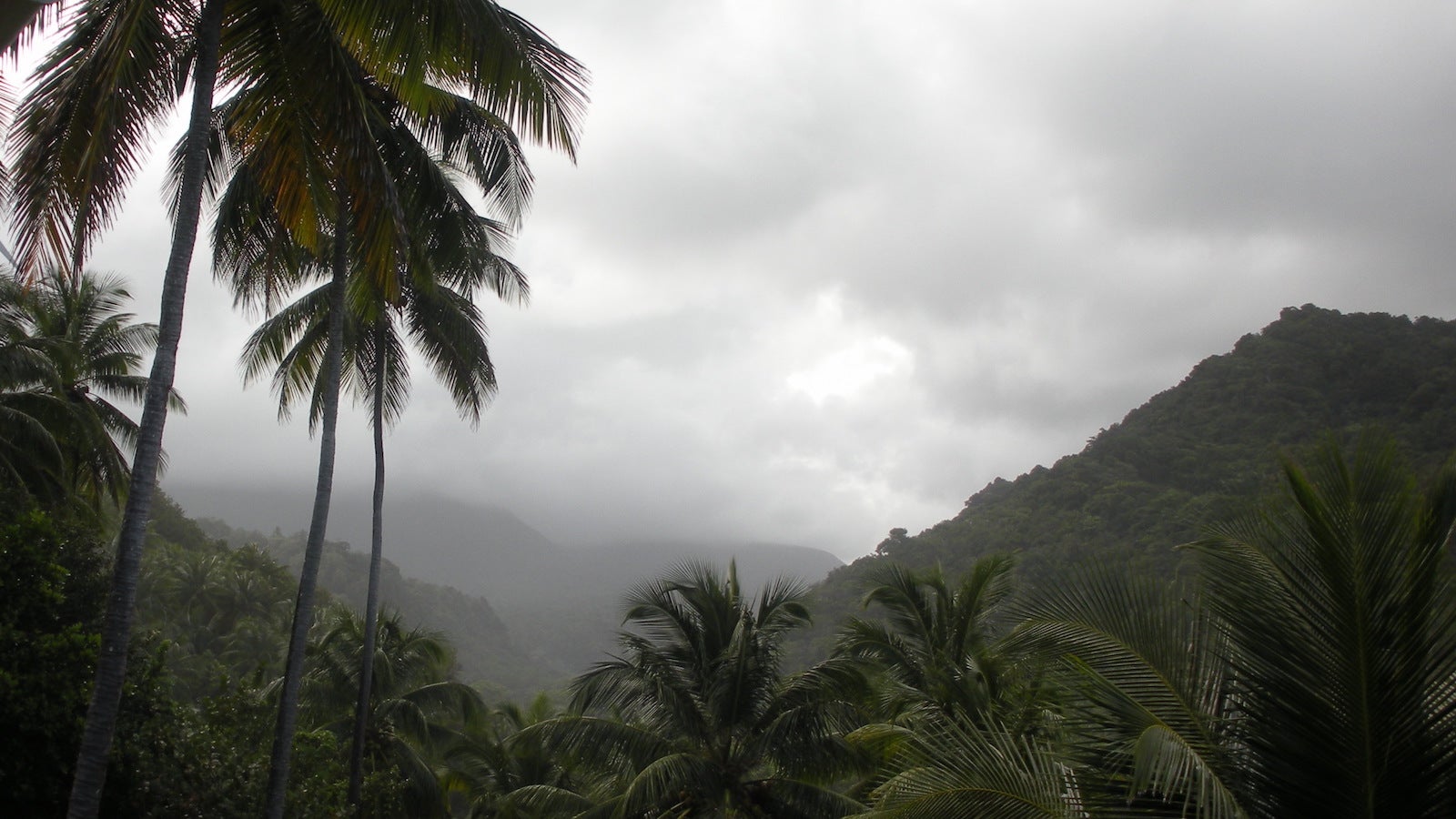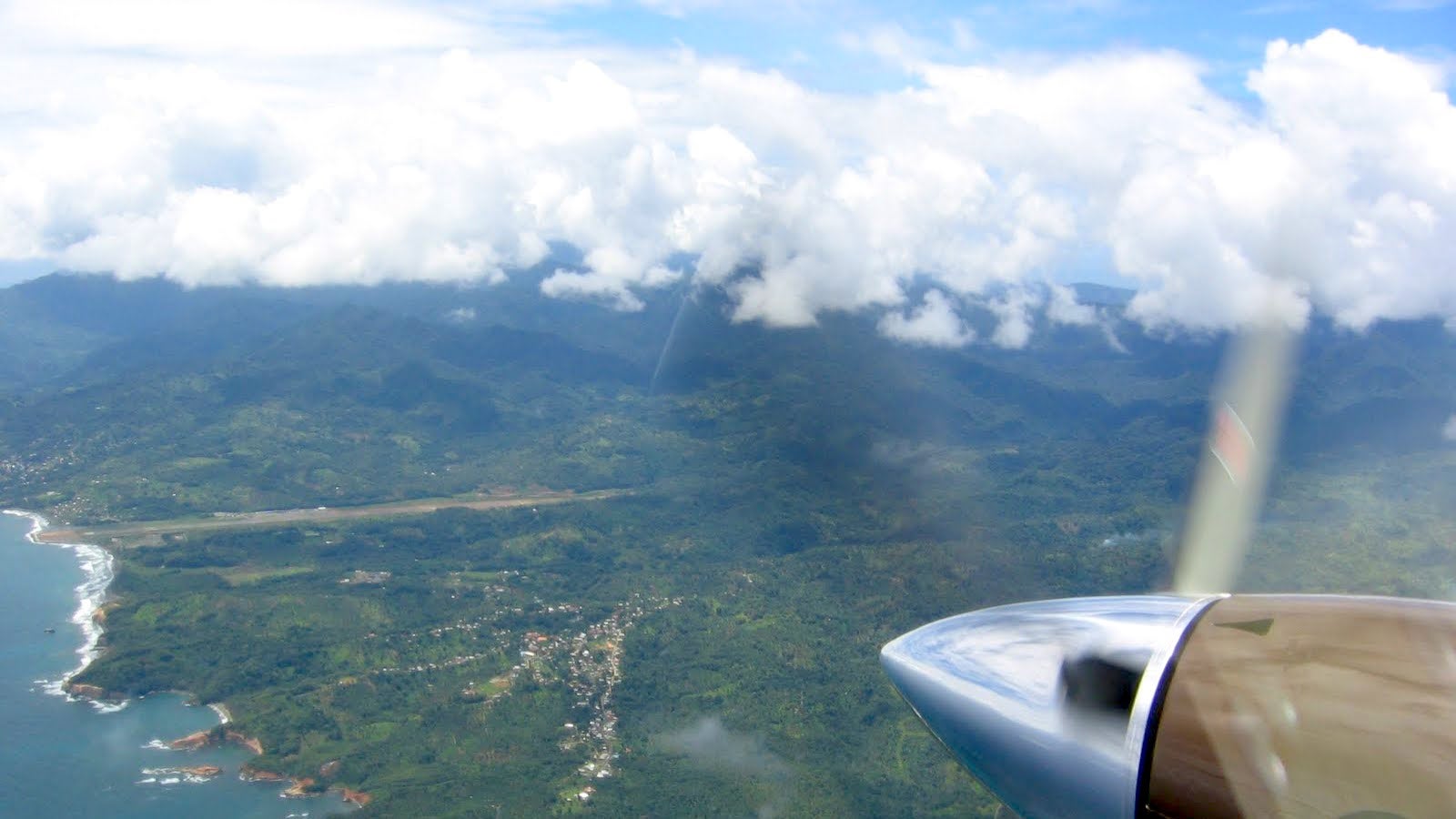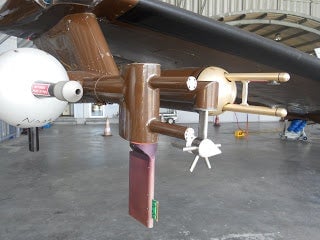Cloud physics could be the key to understanding climate change
It’s raining above Dominica, and cloud physics can’t quite explain why.


It’s raining above Dominica, and cloud physics can’t quite explain why.
Clouds are far more important to the environment than you may think. Not only do they provide some sunburn protection for the fair-skinned and produce rain for crops, but they also act as a buffer for the sun’s radiation and insulate the globe’s heat. This means that understanding how and why they form is essential to predicting, modeling, and perhaps even controlling climate change.
“We want to predict the future, but we are currently struggling to predict these clouds,” says Campbell Watson, an atmospheric scientist who used to study fluffy cumulus formations above the tiny tropical island of Dominica. Moreso than other greenery-covered islands in this region, for six hours a day rain buckets like a sputtering shower head, only broken by brief glimpses of clear blue sky. Conditions change so quickly that even on cool, windless mornings, it could begin pouring by afternoon tea. And no current textbook, study, or climate model can rationalize why.
Here, there are more mountains than men and the ocean is clear as the locale’s white rum. Nestled in the Caribbean Sea about 600 kilometers (370 miles) north-east of Venezuela (and not to be confused with the larger Dominican Republic to its northwest), Dominica is known for a few things: bananas, being the first British Caribbean colony controlled by emancipated black slaves, the Jean Rhys novel Wide Sargasso Sea, and rain. Lots and lots of rain.
While the islanders appear content with their unexplainable rain—they utilize the downpours for hydraulic power—climate-minded scientists are rather keen to solve the conundrum. The consistency and severity of Dominica’s downpours gives them the opportunity to better understand what really goes on 2,000 meters above our heads.
“It is situated in the Caribbean with no islands or terrain upwind or downwind of it,” says Alison Nugent, who did her PhD on the project and is now an assistant professor at the University of Hawai’i at Mānoa. “So you know that whatever happens on the island happens because of the island and nothing else.” This makes Dominica easier to study than mountains situated in the middle of a continent, for example.
To delve into this phenomenon, the Dominica Experiment (also known as DOMEX) was a Yale project funded by the National Science Foundation from 2010 to 2015. Led by the Indiana Jones of orographic-precipitation nerds, professor Ron Smith, the small group of scientists were some of the only people in the world using a combination of mountain meteorology and cloud physics to answer this cloudy quandary. And what they discovered could impact the future of our understanding of climate change.
Why does it rain?
To work out what’s going on above Dominica, we’ll first need a quick recap about how and why it rains. Generally for a cloud to produce rain, the minuscule water droplets it’s made of need to fuse together in a process called collision and coalescence, to form a rain drop. Once a droplet collects enough water and has grown heavy enough, gravity does its thing by pulling it to the ground. It collects more water on its way down and continues to grow through a process called accretion. When this happens en masse, it starts to rain.
Further to this process, there are two sub-varieties of rainclouds: cold clouds and warm clouds. Cold clouds have regions that sit above the freezing level in the atmosphere, turning some of their water into ice crystals that love attracting water vapor. Once the ice crystals have grown large enough they also fall out of the cloud, melt on their way down, and make rain.

But warm clouds sit below the freezing level, meaning there are no helpful ice crystals to help the fusion process along. “How warm clouds rain is a hot topic in cloud physics at the moment,” Watson says, laughing. “People have been guessing for years, but not everybody agrees.” The problem with warm clouds is that similarly sized water droplets bounce off each other instead of fusing together. So you need to create a whole bunch of different sized droplets in your cloud—called a cloud droplet spectrum—so the larger droplets absorb the smaller ones when they bump together. There are a few solid theories on how warm clouds generate this broad spectrum, most of which take up to three hours to gestate.
In Dominica, however, that process happens in 10 to 12 minutes. In the time it takes you to boil pasta, Dominica’s mountains can make a cloud, manufacture a large enough droplet spectrum that it begins to pour, and then quickly dissipate. “All of the current theories on warm clouds can’t explain how this process happens fast enough that you get rain falling so rapidly and heavily in Dominica,” says Watson, who is now working with IBM Research their related business, The Weather Company. “When we look at the data, it throws it back at us. We’re trying to marry observations and modeling to understand a very complicated process.”

In order to pull their data, the team flew a specially equipped plane through the clouds to pick up all sorts of atmospheric information. The twin-engine turboprop King Air, owned and operated by the University of Wyoming as an NSF facility, had instruments on board to measure in-situ physical properties like air motion, turbulence, temperature, and pressure, as well as aerosol, cloud, and rain properties such as number density and size. It also has a cloud radar and a lidar on board.
In the following sped-up time lapse, the aircraft can be seen flying through the clouds taking measurements over Dominica. The instrument in the bottom left of the frame is the gust probe, which “extends forward in front of the aircraft like a narwhal horn,” Nugent says. “It accurately measures the three components of velocity, a difficult feat when your frame of reference is flying through the air at 250 miles per hour.” Many of the instruments onboard measure at 25 hertz—that’s 25 data points per second.
Climate-change modeling and the future of clouds
If and when atmospheric scientists can work out how Dominica’s clouds produce so much rainfall so quickly, they’ll be able to use their findings to contribute to a whole bunch of analyses, one of which being more accurate climate-change predicting models. “If you think about the climate system in its entirety, there are thousands of tiny puzzle pieces that have to be put together,” Watson says. “Clouds in particular are really important through their impact on radiation and therefore warming.” That’s because clouds can both protect us from the sun’s rays by reflecting solar radiation, but they also still allow some of the sun’s rays to transmit through the cloud to the Earth’s surface. The makeup of that delicate balance will have a massive impact on long-term global warming.
The number density and size of the cloud droplets helps determine this ratio, either bouncing the solar radiation back up into space, or allowing it to pass through the cloud to the Earth’s surface, where it can ricochet back up into the cloud to be absorbed and re-emitted, much like the greenhouse effect. In this way, more clouds could be both beneficial (keeping out solar radiation) or harmful (keeping what radiation does come through bouncing between the earth and the clouds). “It’s still very difficult to predict how cloud properties will change in the future, and whether these changes are going to have a warming or cooling effect on Earth,” Watson says. “We know some clouds have a greater cooling effect on our planet, but it’s a challenge because there’s still so much we don’t know about cloud composition around the world.”
“Precipitation is really, really important to life on Earth,” Nugent adds. “Where and how much precipitation falls defines climate regions (think rainforest vs desert) and where humans, plants, and animals can thrive. Clouds are the gatekeepers to precipitation.”
The importance of aerosols
Clouds may save or doom us, but there’s a second factor concerning clouds’ importance to modern research: “We are living in a time where the climate is shifting, and this creates a unique opportunity to observe the changes around us, as if they were controlled experiments,” Nugent says.
A surprising discovery by the team were tiny aerosols floating in the air above Dominica on windless days. Much like the spray from a can of hair spray, aerosols are so small they remain suspended in the air. Some aerosols are naturally occurring, like pollen, spores, smoke, sea salt, and dust, while others come from human activities, like the CFCs that were responsible for the ozone hole over Antarctica. The aerosols above Dominica were naturally occurring and appeared to dramatically affect the cloud droplet spectrum.
Aerosols are important because they are a necessary ingredient for cloud formation. “One of the primary conclusions of the work on Dominica was that precipitation on the island is strongly dependent on wind speed, and in certain scenarios, aerosols” Nugent says. “The dependence on aerosols when the wind speed is low was a surprise to us, and opens up questions of aerosol effects in other scenarios, especially when aerosols are likely to change with climate changes.” Nugent is currently working to determine the effect of aerosols on precipitation in Hawai’i to try and answer some of the unsolved questions from the Dominica case.
Watson and Nugent agree that understanding how rain falls in Dominica—and how that might change with the shifting climate—could be incredibly important for adaptation in the future. We’re still not sure how global warming will affect clouds, and how clouds in turn will affect global warming, but we are learning, one rainy day at a time.